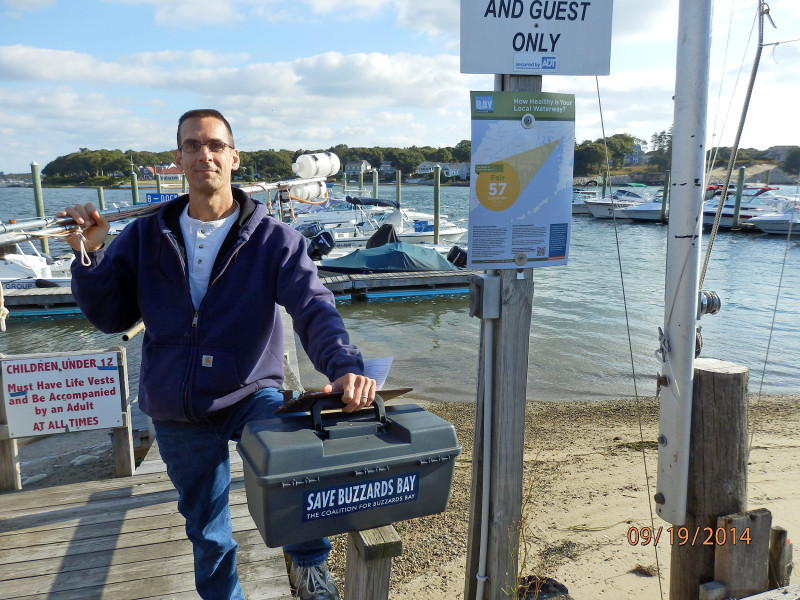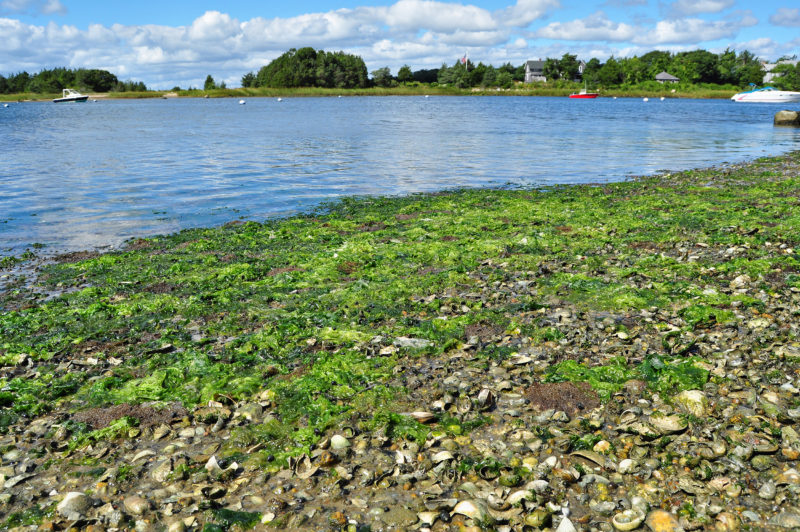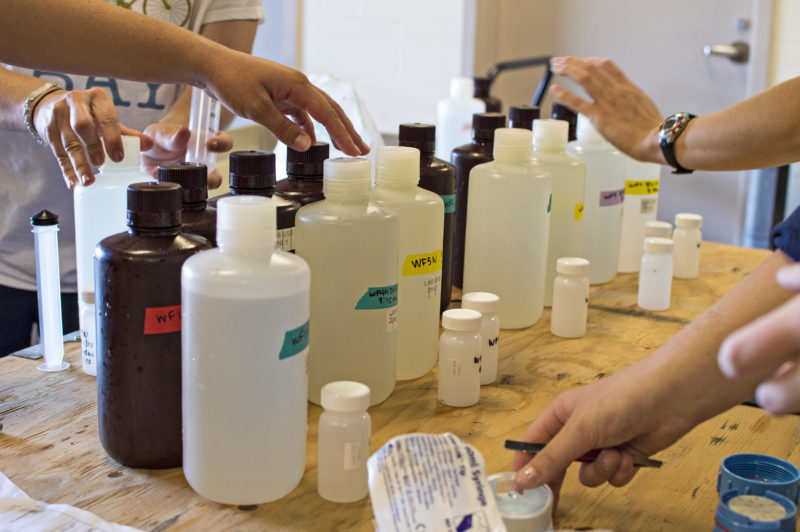With Coalition data, scientists investigating effects of climate change in Buzzards Bay
Every five days in the summer, a team of approximately 100 Buzzards Bay Coalition volunteers head out first thing in the morning to their local beach or dock. The goal of these trained citizen scientists? To take a snapshot of the water’s health.

Volunteer Baywatchers take water samples every summer that help the Coalition track Buzzards Bay’s health over time.
Over the past 24 years, more than 800 volunteers have completed this water testing across Buzzards Bay through the Coalition’s Baywatchers program. From small, gentle freshwater rivers to salty harbors overlooking the Bay, all of the Bay’s local waterways have a collection of information about the water’s health – a body of data that forms the foundation of all the Coalition’s work to protect clean water.
“It’s very unusual to have this scale of data,” said Coalition Science Director Rachel Jakuba, PhD. “[The Baywatchers program] is often lauded as national model of what can be done,” most recently with an EPA Environmental Merit Award in 2012.
Using this long-term Bay Health data – taken at the same time and in the same place year after year – decision makers can put science into action. “All levels of government have used [the Coalition’s] data at one point or another to decide how to manage natural resources,” said Jakuba. “The community depends on this data to track the health of Buzzards Bay.”
Now, scientists are looking at the Coalition’s Bay Health data in a new light. Through a collaborative project with the Woods Hole Oceanographic Institution (WHOI), the Marine Biological Laboratory, and the Buzzards Bay National Estuary Program funded by the John D. and Catherine T. MacArthur Foundation, this data is now allowing scientists to evaluate the effects of climate change on the Bay – and how those effects could be increasing the challenge to save Buzzards Bay.
How is climate change affecting Buzzards Bay?

Warmer water temperatures may be causing more algae to grow in our coastal waters – even in places where nitrogen pollution isn’t increasing.
Scientists have only begun looking at the effects of climate change on Buzzards Bay. But they’ve already found some surprising results.
Looking at temperature data, WHOI found that, in some parts of the Bay, waters have warmed by more than 2 degrees Celsius since monitoring began 24 years ago. That’s roughly 4 degrees Fahrenheit.
“What we’ve seen is that almost every embayment has warmed since data collection began,” said Jennie Rheuban, a research associate at WHOI who is working on this project with the Coalition.
Four degrees may not seem like much. But in fact, it’s a big change for plants and animals that live in the water. “In some cases, a single degree Fahrenheit can mean the difference between a comfortable environment for a fish and an environment where that fish can’t survive,” said Rheuban.
This is the type of fresh look that WHOI is taking at the Coalition’s data. Through this project, scientists hope to identify long-term trends and understand how temperature, oxygen, and other measurements have changed over time. They also want to better understand how certain factors relate to one another – like the relationship between warmer water temperatures and nitrogen pollution.
Nitrogen is the biggest pollution problem facing Buzzards Bay. Too much nitrogen makes the water cloudy and murky with algae. Over time, nitrogen pollution can cause healthy eelgrass beds to die off and oxygen levels to drop, which harms fish, shellfish, and wildlife.
Higher temperatures are like adding fuel to nitrogen pollution. Warm water gives algae a better environment to grow more quickly. Early research in Buzzards Bay is showing that algae is increasing in more places than nitrogen is – and that may be due to warmer water temperatures.
“It may be that in a warming world, the Bay is more susceptible to nutrient pollution,” said Rheuban.
Additionally, nitrogen pollution can lead to ocean acidification, a devastating condition also linked to climate change. When nitrogen-fueled algae blooms die, they decompose in a process that creates carbon dioxide. More carbon dioxide makes the water more acidic, which can harm clams, mussels, and other shellfish.
“Some of the most polluted estuaries are also the most acidified,” said Rheuban.
What types of solutions will this research be used to develop?

Using water samples collected through the Coalition’s Baywatchers program, WHOI scientists will take a closer look at changing conditions in Buzzards Bay.
The ultimate goal of this project goes beyond just studying data. WHOI and the Coalition want to understand the effects that climate change may have on Buzzards Bay so they can figure out what to do about the problem.
For instance, the temperature/nitrogen relationship that scientists are now discovering may affect plans that have already been created to improve the health of waterways across the Bay. In unhealthy harbors and coves like West Falmouth Harbor and Phinneys Harbor, the state has developed cleanup plans called TMDLs that specify how much nitrogen those waterways can handle without becoming even more polluted.
“The previously developed nutrient targets in the TMDLs may not achieve the desired results under current-day conditions,” said Jakuba. “That has substantial implications for water quality goals.” In other words, if these waterways are getting warmer, the established nitrogen limits might not be stringent enough to clean up the water.
With the funding from this project, the Coalition has increased its nitrogen monitoring across Buzzards Bay this summer. Previously, the Coalition only took water samples to test for nitrogen in July and August; this year and next year, nitrogen monitoring will extend from June to September.
The project will also allow the Coalition to gather data on acidification in Buzzards Bay for the first time. Throughout this year, WHOI and the Coalition are gathering samples to test the Bay’s pH: a scale that shows whether the water is acidified. These measurements will allow scientists to come up with a baseline for acidification in the Bay, which, according to Jakuba, “doesn’t exist right now.”
When monitoring for this project is completed at the end of summer 2016, scientists with WHOI will spend the next year analyzing the data to better understand changes in Buzzards Bay over the past 25 years.
“One of the values of this work is knowing whether we need to reduce more nitrogen across Buzzards Bay than we thought,” said Jakuba. “The results of this study could change the equation for towns that need to do this work.”
Many towns are already taking big steps to reduce nitrogen pollution to our coastal waters – particularly from septic systems, the biggest source of nitrogen pollution in the Buzzards Bay region.
- Wareham passed a regulation in 2013 that requires that any new septic system within 500 feet of a waterway be a nitrogen-reducing system. Wareham’s wastewater treatment plant is also a model for other communities that need to upgrade their facilities to remove more nitrogen.
- On West Falmouth Harbor, the Coalition is working to upgrade up to 20 septic systems near the water to nitrogen-reducing systems, which will help speed up the harbor’s recovery.
- In one neighborhood on Red Brook Harbor in Bourne, an innovative partnership is attempting to eliminate septic systems by building a private wastewater treatment facility.
Because nitrogen pollution and ocean acidification seem to be linked, these efforts to stop nitrogen will also help protect shellfish that are susceptible to the effects of climate change. That’s good news, but it also means these pollution problems are especially urgent to fix.
Scientists aren’t ready to make any specific recommendations for Buzzards Bay and its communities until after the study is completed in July 2017. But there are many potential solutions to lessen the effects of climate change – and, just like cleaning up nitrogen pollution, the answers are local.
Jakuba puts it simply: “It’s more important than ever to try and reduce nitrogen pollution in our coastal waters.”